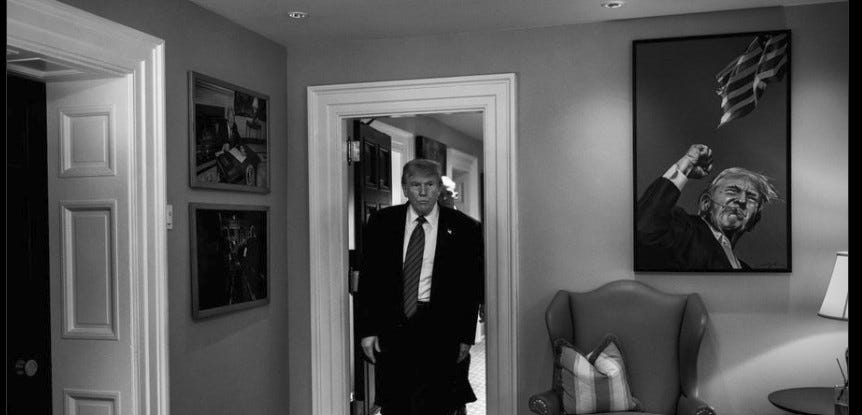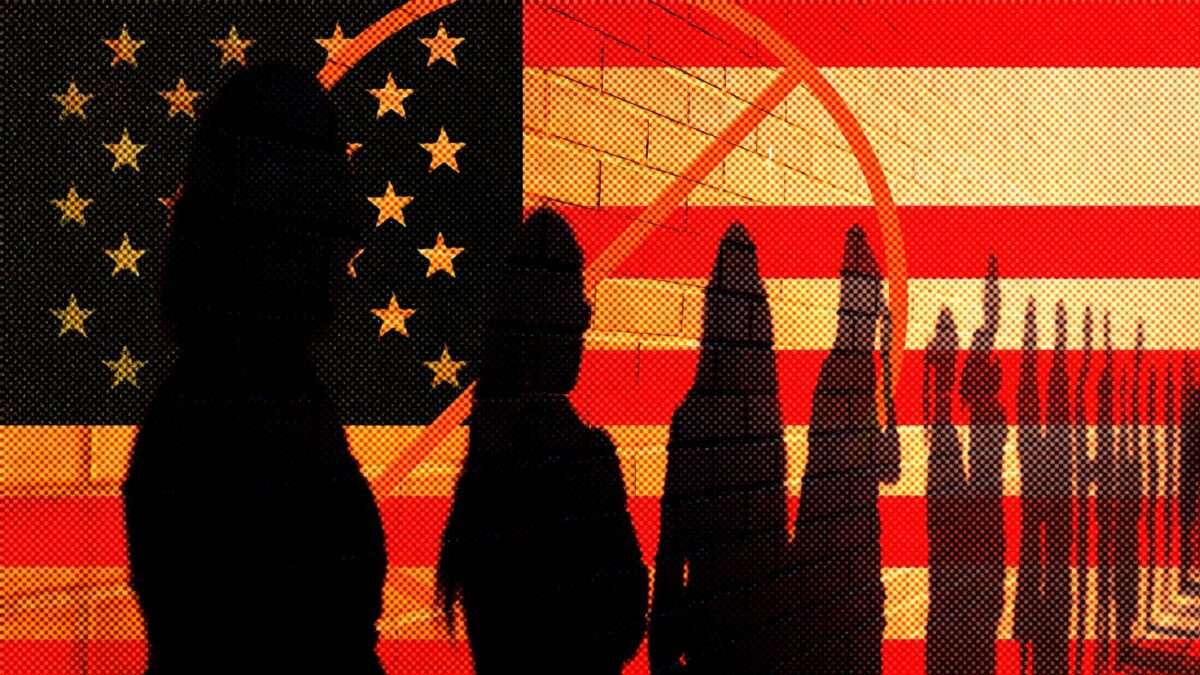
The nationwide anti-Trump No Kings protests, timed to coincide with the June 14 parade honoring the 250th anniversary of the U.S. Army and the president himself, since it’s his birthday, are likely to be the largest demonstrations against the president’s agenda to date. They may prove larger than the “Hands Off” demonstrations in April, larger (at least in geographical scope) than the Women’s March of 2017 following Trump’s first inaugural, and far larger than anything in between. Indivisible plans events in hundreds, perhaps thousands, of sites—but not at the imperial pageant itself: “We will make action everywhere else the story of America that day,” the organizers explain. “For that reason, NO KINGS is not hosting an event in Washington, D.C.”
Can these anti-Trump protests achieve their goals by avoiding civil disobedience as a tactic or by avoiding the president’s heavily armed backyard?
We won’t know until the day’s end on Saturday, and maybe later.
Indivisible, the group organizing the No Kings anti-Trump protests, has what it terms an “Inside/Outside Strategy.” Former Congressional staffers founded the group, and their legislative experience shapes their approach: “We understand systems of power—like how Congress operates—and we work inside them to get results,” explains the group. “That complements our outside strategy of locally-based constituent pressure to demand elected leaders, regardless of political party, work for our democracy.” The drivetrain for change is legislation: “We show up to advocate for policy wins in off-years and get out the vote in election years.”
The theory of their case is that the system’s tools can correct the system’s failures: Pressure elected officials to respond to their constituents; elect officials who address these issues. If Congress understands the size and depth of opposition to the Trump administration, Indivisible argues, they’ll rein it in. Republicans, at least from swing areas, will fear being sent packing and start using their power of oversight. Democrats will fear aggressive primary challengers and be deterred from cowering.
The 2017 women’s march had its foibles. A leading figure organizing it had made antisemitic statements, the “pussy hat” motif may have turned off some Americans who may otherwise have been sympathetic to its aims but were annoyed or perplexed by the ham-handed reference to Trump’s grab-‘em-by-the-pussy line on the Access Hollywood tape that disrupted but didn’t derail his 2016 campaign. The march, though, had profound effects, partly by leading to other protests like the very effective ones at airports that led to the reversal of Trump’s Muslim ban, but far more powerfully on the electoral front. It helped catalyze a dgeneration of women to run for office, arguably leading to the GOP trouncing in the 2018 midterms and the very successful class of House Democrats that emerged from that, including this year’s two heavily favored gubernatorial candidates, Representative Mikie Sherill of New Jersey and former Representative Abigail Spanberger, a Naval Academy graduate and former CIA officer respectively.
 Defund the Left. Workers install security fencing on the National Mall on Tuesday, June 10, 2025, outside the USDA Whitten Building, where a large photograph of President Donald Trump is draped, in Washington. The president has waged war on the civil service as part of his efforts to defund the left. Anti-Trump, No Kings demonstrations will take place nationwide. Credit: (AP Photo/Jacquelyn Martin)
Defund the Left. Workers install security fencing on the National Mall on Tuesday, June 10, 2025, outside the USDA Whitten Building, where a large photograph of President Donald Trump is draped, in Washington. The president has waged war on the civil service as part of his efforts to defund the left. Anti-Trump, No Kings demonstrations will take place nationwide. Credit: (AP Photo/Jacquelyn Martin)
Indivisible’s strategy here is the same as in 2017. It may be proven exactly right—avoid confrontation, show Americans who oppose what Trump is doing that they are not alone, build networks, and then utilize and grow those networks for more protesting, but more importantly, for electoral victories.
If you believe we’re past the point of free and fair elections or that Trump has already dealt a devastating blow to democracy, then more audacious techniques may be required for anti-Trump protests, like civil disobedience, which made sense in the civil rights era when rights were widely denied to Americans—Blacks most excruciatingly but also Jews, women, homosexuals, and so on.
Confrontation through civil disobedience doesn’t mean violence, so it has the word “civil.” Henry David Thoreau, Mahatma Gandhi, and Martin Luther King Jr. knew that. Indivisible, like the organizers of Black Lives Matter, Occupy Wall Street, and most other progressive movements, also rejects violent tactics. That doesn’t hold, of course, for protesters such as the Proud Boys, Oath Keepers, January 6 insurgents, or leftist anarchists of the Antifa variety. However, the types of protests that have brought about real change have some ruckus. The recent Los Angeles demonstrations were a kind of hybrid. Some real civil disobedience and the type of rock-throwing King would have abhorred. The embrace of Mexican flags versus the stars and stripes everywhere at civil rights marches was also antithetical to King.
Mahatma Gandhi, a no-exceptions pacifist and the patron saint of nonviolent protest, sternly rejected the idea that his movement should avoid conflict. He said that his method of action “differs from Passive Resistance as the North Pole from the South.” King, who brought Gandhi’s methods to America, wrote, “Nonviolence is a powerful and just weapon, which cuts without wounding and ennobles the man who wields it.”
Civil rights protesters of the 1960s knew all about “good trouble,” as John Lewis famously said. The late representative and civil rights icon, like too many others, was beaten within an inch of his life, suffering his most grievous wounds in 1965 in Selma, Alabama, as civil rights marchers disobeyed state and local law enforcement’s instructions to discontinue their journey. King, like Gandhi before him, was often imprisoned. In Alabama, civil rights activists used civil disobedience to seek out conflict, from the voting rights march in Selma to the 1957 Montgomery bus boycott to the protests against segregated accommodations in Birmingham in 1963.
 The 1963 March on Washington: Are there parallels to anti-Trump protests on June 14? Credit: Wikimedia Commons Credit: Wikimedia Commons
The 1963 March on Washington: Are there parallels to anti-Trump protests on June 14? Credit: Wikimedia Commons Credit: Wikimedia Commons
The 1963 March on Washington, D.C., the site of King’s famous “I Have a Dream Speech,” was nonviolent and had all the legal permits, but it was highly confrontational, different from the women’s march because of the times. Some 250,000 people, many of them Black, were effectively disenfranchised, converging on a capital only recently desegregated—for many of those in power, including John F. Kennedy’s administration pushing a civil rights bill, it was terrifying. Liquor stores were closed for days. Law enforcement preparations were massive. The power of the march was in defying widespread expectations that it would turn violent. A peaceful protest may or may not have such power today. We’ll find out.
In Jim Crow America, the tools of democracy were inadequate for the challenge: It was precisely these democratic rights that the protesters were being denied. Perhaps the majority would eventually grant the population full citizenship, but they hadn’t. Even King’s nonviolent movement might have faltered without the prospect of figures like Malcolm X, who refused to declare violence off-limits. “By any means necessary,” he said.
Perhaps rallies far from the imperial throne will induce Congressional Republicans to discover Article I of the Constitution. Changing the narrative to courthouses and town squares may prove genius. Or it may seem too bougie, too detached from the moment.
It might be because America today looks increasingly like the America of 1963, where the rule of law doesn’t mean much for a vast swath of our population.
That said, Indivisible was brave to sponsor the outside-the-beltway marches. It’s a peaceful and permitted approach that helps build the muscles for future battles. It’s good exercise. Whether it’s adequate for the moment, we’ll find out.
The choice may not be ours to make: For Donald Trump, all disobedience is uncivil. He threatened that any protest would be met with “very heavy force,” although it wasn’t clear if he was talking about it just in the District of Columbia or nationwide. As bad as it was to Shanghai the National Guard, or send the Marines to L.A., it could get worse. When faced with a nonviolent demonstration in his first term, he asked Defense Secretary Mark Esper to “just shoot them in the legs or something;” his current subordinates wouldn’t hesitate. A wise would-be monarch would ignore the protests and feast on the parade, but Trump cannot overlook even the slightest hint of lèse majesté. So we’ll see what he does and whether the protests are influential or ineffective.
The post What the Anti-Trump Protests Mean for Democracy appeared first on Washington Monthly.


 16 hours ago
4
16 hours ago
4 










 Bengali (Bangladesh) ·
Bengali (Bangladesh) ·  English (United States) ·
English (United States) ·